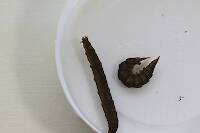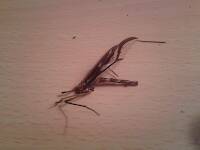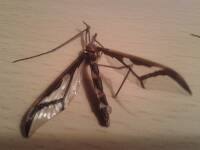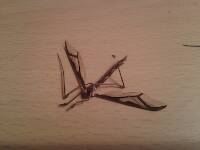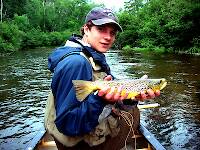
Salmonflies
Pteronarcys californica
The giant Salmonflies of the Western mountains are legendary for their proclivity to elicit consistent dry-fly action and ferocious strikes.
Featured on the forum

This seems to be a young larva of Limnephilus. Although not clear in the picture, several ventral abdominal segments have chloride epithelia.

Troutnut is a project started in 2003 by salmonid ecologist Jason "Troutnut" Neuswanger to help anglers and
fly tyers unabashedly embrace the entomological side of the sport. Learn more about Troutnut or
support the project for an enhanced experience here.
Lam on Oct 18, 2007October 18th, 2007, 1:30 pm EDT
I have seen crane flies tied in various ways and on sale in practically every fly shop I have visited. Hence, I assumed they hatched in or near water.
Just recently, my lawn has erupted with hatch after hatch of crane flies. Which, of course, made me reexamine my original assumption that they hatched in or near water. I decided to check the ole internet and sure enough, the larva are underground and love to eat grass roots. It goes on to say that the larva "may" cause damage to lawns.
Well, over the past few years "grubs" have been a big lawn problem around here. It seems that the "grubs" are crane fly larva. Who knew? Now, if I can only introduce a predatory species, say...trout, I could eliminate the problem. Do you think trout will survive if I throw them in my lawn? God knows there are enough crane flies to keep them fat and happy, I just have to figure out how to flood my yard.
Just recently, my lawn has erupted with hatch after hatch of crane flies. Which, of course, made me reexamine my original assumption that they hatched in or near water. I decided to check the ole internet and sure enough, the larva are underground and love to eat grass roots. It goes on to say that the larva "may" cause damage to lawns.
Well, over the past few years "grubs" have been a big lawn problem around here. It seems that the "grubs" are crane fly larva. Who knew? Now, if I can only introduce a predatory species, say...trout, I could eliminate the problem. Do you think trout will survive if I throw them in my lawn? God knows there are enough crane flies to keep them fat and happy, I just have to figure out how to flood my yard.
Smallstream on Oct 18, 2007October 18th, 2007, 2:47 pm EDT
flooding your lawn would br pretty sweet, i always said that if I became rich, I would create an artificial trout pond or stream in my backyard
Taxon on Oct 18, 2007October 18th, 2007, 4:35 pm EDT
Gene
Posts: 107
Posts: 107
Gene on Oct 18, 2007October 18th, 2007, 6:05 pm EDT
Gentlemen:
There are many aquatic species also. In fact, craneflies used to have more total species in Diptera than total number of mayflies, stoneflies, or caddisflies species.
They are a very tough group and can withstand many forms of pollution. I have found them surviving after streams dropped below the pH of battery acid in some AMD streams.
I think their larvae are the "cockroaches" of the stream if you know what I mean. There larvae are ugly bastards compared to the rest of the macroinvertebrate world.
tight lines and beautiful nymphs
gene
www.eugenemacri.com
There are many aquatic species also. In fact, craneflies used to have more total species in Diptera than total number of mayflies, stoneflies, or caddisflies species.
They are a very tough group and can withstand many forms of pollution. I have found them surviving after streams dropped below the pH of battery acid in some AMD streams.
I think their larvae are the "cockroaches" of the stream if you know what I mean. There larvae are ugly bastards compared to the rest of the macroinvertebrate world.
tight lines and beautiful nymphs
gene
www.eugenemacri.com
Martinlf on Oct 19, 2007October 19th, 2007, 1:07 am EDT
One of my favorite flies, a simple ugly cigar-shaped fly tied of hare's ear with no rib or anything, called a Walt's Worm by the folks around State College, is often thought of as a crane fly larva imitation, and I've had some fantastic fall fishing on dry flies tied to imitate crane flies.
"He spread them a yard and a half. 'And every one that got away is this big.'"
--Fred Chappell
--Fred Chappell
Falsifly on Oct 19, 2007October 19th, 2007, 4:56 am EDT
Many years ago I hade the pleasure of watching a nice brown feeding on the large adult Crane flies. They appeared to be ovipositing under a low hanging tagalder along the bank. The flies would maintain a position just inches above the surface and momentarily dip to the water. The brown was literally taking the flies from midair. Having nothing in my possession coming close to an imitation was only half the problem. It appeared that the only succesful tactic would be to dap thru the tagalder branches. A recipe for disaster I was convinced. However, a memory ingrained forever.
Falsifly
When asked what I just caught that monster on I showed him. He put on his magnifiers and said, "I can't believe they can see that."
When asked what I just caught that monster on I showed him. He put on his magnifiers and said, "I can't believe they can see that."
Jmd123 on Oct 20, 2007October 20th, 2007, 7:31 pm EDT
Crane flies, family Tipulidae, are an interesting and diverse bunch. Many of them are "shredders", turning pieces of leaves, bark, etc. into much finer particles, which contribute to the nutrient content of the stream and also provide food for the "filter feeders" (including many caddisflies and midges). A few genera are predators. Homely they may be, but they are nice little packages of protein that make great fish food. Some genera are tolerent of pollution, but others are not - these typically inhabits small headwater streams where they essentially create the base of the food chain by converting leaves into food and nutrients from others.
A good adult imitation would be a spider pattern - overhackle a standard dry fly hook and skitter it across the water like you see the naturals doing.
Jonathon
A good adult imitation would be a spider pattern - overhackle a standard dry fly hook and skitter it across the water like you see the naturals doing.
Jonathon
No matter how big the one you just caught is, there's always a bigger one out there somewhere...
Quick Reply
Related Discussions
Topic
Replies
Last Reply







